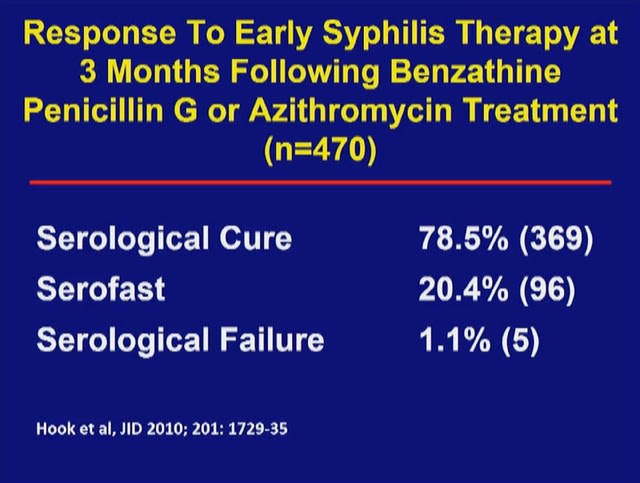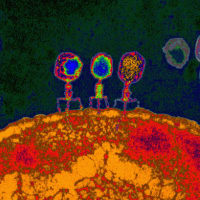
引き続き、前回と同様にEdwardW. Hook先生による梅毒の話しです。
今日のテーマは「Serofast」、治療しても非トレポネーマ検査の値が下がらない。(正確には治療により最初下がっていく血清の値が、例えばRPRの値が最初の半分程度になり、やがてPlateauになってそれ以上低下しない現象のこと)
Serofastになりにくい症例は以下のとおり:
・若い
・初期梅毒(一期>二期>早期潜伏期)
・Jarisch-Herxheimer Reactionを起こした!!
・最初の値が高い
注:編集長的には免疫反応が良い状態といった感じ
これは治療失敗ではありません。

Clin Infect Dis. 2011 Dec;53(11):1092-9.
Predictors of serological cure and Serofast State after treatment in HIV-negative persons with early syphilis.
Seña AC et al.
Abstract
BACKGROUND:
Syphilis management requires serological monitoring after therapy. We compared factors associated with serological response after treatment of early (ie, primary, secondary, or early latent) syphilis.
METHODS:
We performed secondary analyses of data from a prospective, randomized syphilis trial conducted in the United States and Madagascar. Human immunodeficiency virus (HIV)-negative participants aged ≥ 18 years with early syphilis were enrolled from 2000-2009. Serological testing was performed at baseline and at 3 and 6 months after treatment. At 6 months, serological cure was defined as a negative rapid plasma reagin (RPR) test or a ≥4-fold decreased titer, and serofast status was defined as a ≤ 2-fold decreased titer or persistent titers that did not meet criteria for treatment failure.
RESULTS:
Data were available from 465 participants, of whom 369 (79%) achieved serological cure and 96 (21%) were serofast. In bivariate analysis, serological cure was associated with younger age, fewer sex partners, higher baseline RPR titers, and earlier syphilis stage (P ≤ .008). There was a less significant association with Jarisch-Herxheimer reaction after treatment (P = .08). Multivariate analysis revealed interactions between log-transformed baseline titer with syphilis stage, in which the likelihood of cure was associated with increased titers among participants with primary syphilis (adjusted odds ratio [AOR] for 1 unit change in log(2) titer, 1.83; 95% confidence interval [CI], 1.25-2.70), secondary syphilis (AOR, 3.15; 95% CI, 2.14-4.65), and early latent syphilis (AOR, 1.86; 95% CI, 1.44-2.40).
CONCLUSIONS:
Serological cure at 6 months after early syphilis treatment is associated with age, number of sex partners, Jarisch-Herxheimer reaction, and an interaction between syphilis stage and baseline RPR titer.
doi: 10.1093/cid/cir671. Epub 2011 Oct 12.
PMID: 21998287
今日のテーマは「Serofast」、治療しても非トレポネーマ検査の値が下がらない。(正確には治療により最初下がっていく血清の値が、例えばRPRの値が最初の半分程度になり、やがてPlateauになってそれ以上低下しない現象のこと)
Serofastになりにくい症例は以下のとおり:
・若い
・初期梅毒(一期>二期>早期潜伏期)
・Jarisch-Herxheimer Reactionを起こした!!
・最初の値が高い
注:編集長的には免疫反応が良い状態といった感じ
これは治療失敗ではありません。

Clin Infect Dis. 2011 Dec;53(11):1092-9.
Predictors of serological cure and Serofast State after treatment in HIV-negative persons with early syphilis.
Seña AC et al.
Abstract
BACKGROUND:
Syphilis management requires serological monitoring after therapy. We compared factors associated with serological response after treatment of early (ie, primary, secondary, or early latent) syphilis.
METHODS:
We performed secondary analyses of data from a prospective, randomized syphilis trial conducted in the United States and Madagascar. Human immunodeficiency virus (HIV)-negative participants aged ≥ 18 years with early syphilis were enrolled from 2000-2009. Serological testing was performed at baseline and at 3 and 6 months after treatment. At 6 months, serological cure was defined as a negative rapid plasma reagin (RPR) test or a ≥4-fold decreased titer, and serofast status was defined as a ≤ 2-fold decreased titer or persistent titers that did not meet criteria for treatment failure.
RESULTS:
Data were available from 465 participants, of whom 369 (79%) achieved serological cure and 96 (21%) were serofast. In bivariate analysis, serological cure was associated with younger age, fewer sex partners, higher baseline RPR titers, and earlier syphilis stage (P ≤ .008). There was a less significant association with Jarisch-Herxheimer reaction after treatment (P = .08). Multivariate analysis revealed interactions between log-transformed baseline titer with syphilis stage, in which the likelihood of cure was associated with increased titers among participants with primary syphilis (adjusted odds ratio [AOR] for 1 unit change in log(2) titer, 1.83; 95% confidence interval [CI], 1.25-2.70), secondary syphilis (AOR, 3.15; 95% CI, 2.14-4.65), and early latent syphilis (AOR, 1.86; 95% CI, 1.44-2.40).
CONCLUSIONS:
Serological cure at 6 months after early syphilis treatment is associated with age, number of sex partners, Jarisch-Herxheimer reaction, and an interaction between syphilis stage and baseline RPR titer.
doi: 10.1093/cid/cir671. Epub 2011 Oct 12.
PMID: 21998287

























